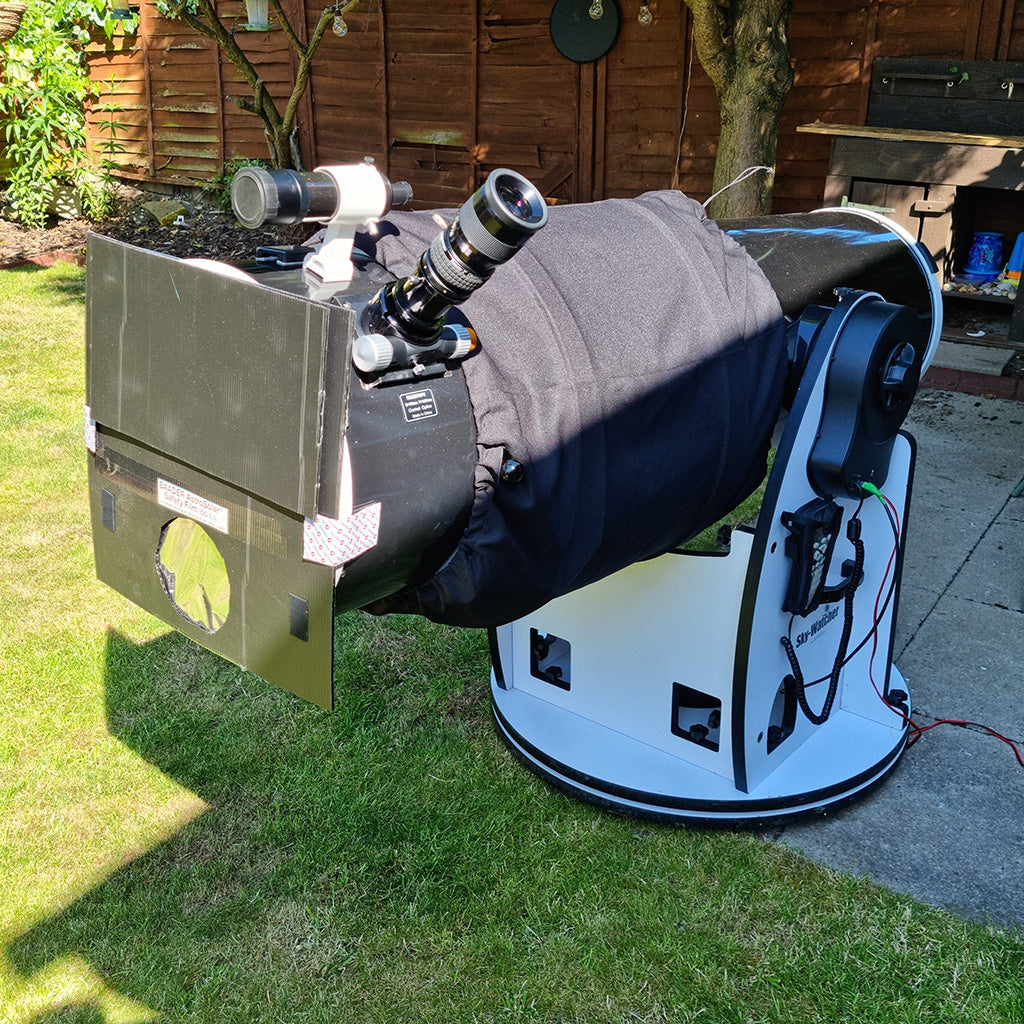
Making an inexpensive filter cell using Baader AstroSolar Film
Baader Planetarium offer a range of Solar filters for viewing and imaging the Sun.
One of the most popular, and inexpensive, Solar filters they offer is their AstroSolar sheets which are ~A4 in size (20x29cm).
These A4 sheets are available in
A fun part of buying one of these AstroSolar sheets is being able to make your own filter holder for your telescope, camera lens or binoculars.
How to make an inexpensive filter cell using Baader AstroSolar Film
Creating a solar filter using Baader AstroSolar Safety Film is a great way to safely observe the Sun during a solar eclipse, and with the Great North American Solar Eclipse just around the corner there is no better time to prepare and test to ensure trouble free usage during the event.
Materials you will need:
- Baader AstroSolar Safety Film
- Cardboard or stiff poster board
- Scissors or a craft knife
- Tape (preferably duct tape or gaffer tape)
- Ruler or measuring tape
- Pencil or marker
- Hole punch (optional)
Simple Filter Cell
You don't need to make a filter cell to be able to use Baader AstroSolar Safety Film. For instance, if you can wrap the solar film over the edge of a camera lens of binocular, you can simply attach it using an elastic band.
Here are step-by-step instructions on how to make a filter using the film:
The film must be mounted flat and free of any tension - Only this will provide first class optical properties. The quality of this patent pending material is so high that any strain on the film will lead to a very noticeable deterioration of optical quality (it is preferable to have a few mild wrinkles than to place the film under stress from pulling it).
When mounted carefully, AstroSolar can reach the quality levels of truly precision polished glass plates (not to be compared with the commonly available glass filters made of ordinary window glass w/o ever having seen a polishing machine).
The "Cylinder"
At first you have to produce a cylinder of cardboard, to exactly match the outer circumference of your Telescope tube or dew cap. In order to achieve this, cut a whole number of cardboard layers, approx. 5 -6cm (2 inches) wide. Wrap one piece of cardboard around your dew cap or lens cell and glue one end onto the other.

The "Window Cell"
Cut out two rings of cardboard (each having 1 - 2mm thickness). The outer diameter of the ring - shaped cardboard should match the outer diameter of your fabricated "cylinder". The inner diameter should correspond to the actual aperture of the instrument.
After having prepared two such rings, both should be equipped on adjacent sides with a large number of small cutouts of double tape along the outer circumference of both rings. Now comes the tricky part - how to get the AstroSolar onto the taped ring w/o wrinkles or ripples. The film must not be scratched - so put one sheet only of Kleenex (or other soft tissue) onto a flat table. Tape the Kleenex onto the table so that this part is stretched out evenly and cannot move on you. Only now put a square piece of film - (precut to the size of the cardboard-rings) onto the piece of soft tissue. Do not tape the film and do not stretch it! Just let it rest relaxed and flat on the Kleenex.
Please Note: Before mounting the AstroSolar, be sure to peel off the removable clear protective film that is present on one side of the film.


Now take the first cardboard ring and lower it straight down onto the film until every double tape clipping made contact with the film. Turn this package around, tape the other ring onto the opposite side and cut away the overleaf. Now your AstroSolar TM should be mounted free from strain and wrinkles between the two cardboard rings. Finally glue this "window holder" onto the prefabricated "Cylinder". Now your "Do it Yourself" precision Solar Filter or Optical Window is ready.
When covering a larger Newtonian or Cassegrain Telescope for Planetary Observation, you may want to also try an "off axis filter cell". The reduced aperture may enable your large telescope to perform to the level of a good refractor (by eliminating the central obstruction and effects of turbulence on the larger aperture). Or. for maximum resolution, a full axis filter can be made from our new Maximum sized AstroSolar (46" x 46").

Baader Instructions for Telescope and Binoculars
Baader Planetarium have published a useful guide on how to make such a filter holder you may find useful:
The Alternative
Is all of this handcrafting too much work for you? Are you afraid you might do something wrong? Then we have the solution for you! With Baader's Solar Telescope Filters – produced with AstroSolar® Safety Film OD 5.0 – there is now a solution for an affordable price for nearly all Telescopes, Spotting Scopes, Binoculars and Tele- / Camera lenses.
Offset Solar Filter Example for Dobsonian
This homemade filter was made using both ND5 and ND3.8 for a 16” Dobsonian. The filter can be switched between the densities easily.

Switchable Offset Homemade Dobsonian Baader AstroSolar Safety Film - Currently Set to OD5.0



Leave a comment